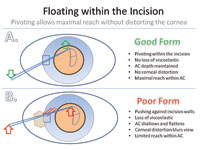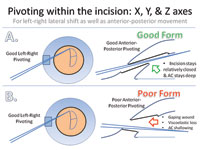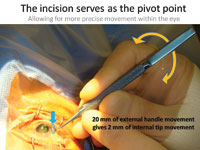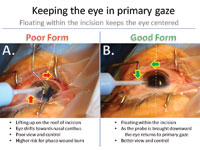Surgeons should master pivoting, maneuvering within the eye
These techniques enable safer surgery with less induced trauma and a faster recovery of vision.
Intraocular procedures pose the surgical challenge of working within a very small space, with limited room in which to maneuver instruments. In this regard, eye instrumentation is very small, with fine tips that are no more than millimeters in dimension. Surgeons who use these instruments within the eye learn to pivot within small incisions to avoid collapse or distortion of the anterior chamber. Our goal is a minimally invasive procedure with a low degree of surgically induced trauma so that the eye is quieter, with less inflammation and a rapid recovery of excellent vision.
Pivoting technique
Moving any instrument with a pivoting technique allows a wide range of movement while the instrument is inserted through a smaller incision. There is also increased precision, because a large movement outside the pivot can produce a small movement inside the eye.
Think of a rowboat and a paddle with an oar lock. Although the part of the paddle in the water moves many yards with each stroke, the handle portion of the oar moves only a few feet within the boat. With eye instruments, it is the reverse: A long handle outside the eye will move many centimeters while the short tips within the eye move just a few millimeters. This scaling allows for more precise control of intraocular instrumentation. And because the ocular incisions act like an oar lock, this pivoting movement can be accomplished through very small wounds.

Floating within the phaco incision and using a pivoting technique allow maximal reach and control during surgery.

The pivoting technique must be used in all dimensions: left-right movement (x axis), forward-backward movement (y axis) and anterior-posterior positioning (z axis).
Images: Devgan U

By using the pivoting technique during capsulorrhexis creation, this surgeon shows that a large 20-mm movement of the external instrument handle gives a very precise 2-mm movement of the internal tip of the forceps, thereby increasing precision.

If the surgeon lifts up on the temporal incision, the eye will tend to move toward the nasal canthus (a), which limits the view and control and poses a higher risk for a phaco wound burn. By lowering the phaco probe and allowing it to float within the incision (b), the eye returns to primary position and provides a better view and control for the surgeon.
The correct form is to pivot within the incision during surgery, which means that the hand of the instrument should move to the right if you would like the tip of the instrument to move to the left. This keeps the corneal incision relatively closed and undistorted, allows viscoelastic to be retained within the anterior chamber to maintain depth, and gives maximal reach within the eye.
The incorrect technique is to push against the incision walls, trying to move the instrument handle in the same direction as the instrument tip. This causes distortion of the cornea as the instrument pushes against the walls of the incision, limiting the view and allowing viscoelastic to escape from the eye, leading to collapse of the anterior chamber. The reach within the eye is also compromised if the surgeon does not employ the pivoting technique.
Surgery is three-dimensional and we must be able to move left and right (x axis), forward and backward (y axis), and anteriorly and posteriorly (z axis). These same principles of pivoting within the incision apply in all of these dimensions. In particular, a failure to properly pivot in the z axis can lead to extensive gaping of the phaco incision, which causes loss of viscoelastic or saline solution and anterior chamber collapse during cataract surgery, making a complication such as a posterior capsular rupture far more likely.
Floating within the incision
In addition to pivoting, we must also float within the phaco incision so that the eye stays in primary gaze. There is a tendency for beginning surgeons to lift up on the phaco incision, which causes the eye to shift out of primary position. For temporal phaco incisions, this causes the eye to move toward the nasal canthus, which limits surgeon visibility and control, may cause patient discomfort, and predisposes to a phaco wound burn.
When the phaco probe tip is forcefully pushed against the roof of the corneal incision, there is increased friction and heat from the ultrasonic vibrations in close proximity to the corneal stromal tissue without the benefit of adequate fluidic cooling. Resultant phaco wound burn can induce a large degree of irregular astigmatism and a poor visual result.
Also of importance is the surgeon’s non-dominant hand, which controls instruments such as phaco choppers that are placed through the paracentesis incision. With the surgeon focusing much of his effort on the phaco probe in the dominant hand, the hand holding the chopper may tend to wander or inadvertently place pressure on the paracentesis incision. This leads to distortion and increased fluidic leakage from the paracentesis, which can be enough to upset the fluidic balance of the phaco machine.
When the eye is moving toward the nasal canthus, gently bring the phaco probe down until the eye is back in primary gaze with the iris parallel to the floor. When instruments are inserted within the eye, the surgeon’s movement of these tools, not the patient’s voluntary muscle control, determines the eye’s position.
By allowing our surgical instruments to gently float within the incisions and by using the pivoting method, we can keep the eye in its primary position and maintain good visualization throughout the surgery. These techniques can be challenging to learn for the beginning surgeon, but with practice they become second nature. And most importantly, we can perform a safer surgery for our patients with less induced trauma and a faster recovery of good vision.
